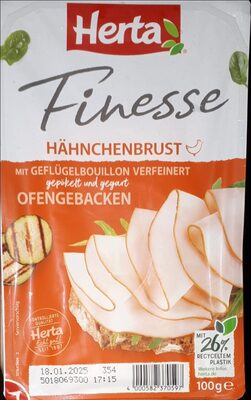
Barcode: 4000582370597
Hähnchenbrust
DOUBTFUL
📝 Reason: The product contains several ingredients derived from chicken, such as Hähnchenbrustfilet, Hühnchenhaut, Hühnchenfleisch, and Hühnchenfett, which are marked as Doubtful due to the absence of Halal certification. According to Islamic dietary laws, meat must be slaughtered in a Halal manner to be considered permissible. Without proper certification, the Halal status of these ingredients cannot be confirmed, leading to the overall product being classified as Doubtful.
📄 Certificates: None
Ingredients:
Details
Understanding the Halal Status of Hähnchenbrust
Hähnchenbrust, a popular chicken breast product, raises questions regarding its Halal status. Being a staple in many diets, it is crucial for consumers, especially Muslims, to know if Hähnchenbrust is Halal or not. In this article, we delve into the ingredients of Hähnchenbrust, including various additives. Additionally, we will evaluate the Halal certification status of each component to give you a comprehensive overview.
Halal Certification Context
According to Islamic dietary laws, meat is considered Halal only if it has been slaughtered following Islamic procedures. Importantly, Halal certification from a credible authority plays a vital role in ensuring compliance with these laws. Unfortunately, Hähnchenbrust lacks any Halal certification, placing its Halal status in the category of ‘Doubtful’.
Ingredients Breakdown
The composition of Hähnchenbrust includes:
- Hähnchenbrustfilet – Halal logo missing
- Geflügelbouillon – Halal logo missing
- Wasser – Generally considered Halal
- Hühnchenhaut – Halal logo missing
- Hühnchenfleisch – Halal logo missing
- Zucker – Generally considered Halal
- Salz – Generally considered Halal
- Maisstärke – Generally considered Halal
- Hühnchenfett – Halal logo missing
- Zwiebelsaftkonzentrat – Generally considered Halal
- Dextrose – Generally considered Halal
- Kaliumacetat (E261) – Not in the Haram E-Code list
- Natriumacetate (E262) – Not in the Haram E-Code list
- Natriumnitrit (E250) – Not in the Haram E-Code list
- Triphosphate (E451) – Not in the Haram E-Code list
- Natriumascorbat (E301) – Not in the Haram E-Code list
- Aroma – Halal logo missing
Analysis of E-Numbers and Ingredients
Let’s delve deeper into the E-numbers and their implications regarding Halal status:
- E261 (Kaliumacetat): Generally safe and not categorized as Haram.
- E262 (Natriumacetate): Also not found in Haram E-Code lists, hence considered Halal.
- E250 (Natriumnitrit), E451 (Triphosphate), E301 (Natriumascorbat): These E-numbers are generally accepted in Halal diets as they do not originate from any Haram source.
However, the primary ingredients like Hähnchenbrustfilet, Hühnchenhaut, and Hühnchenfleisch are flagged due to the lack of Halal certifications. Without such certainties, the risk of consuming non-Halal meat remains.
Conclusion
In conclusion, the overall Halal status of Hähnchenbrust is classified as ‘Doubtful’. The presence of vital chicken components that lack proper Halal certification raises serious concerns for Halal-conscious consumers. It is imperative to exercise caution and seek clear certification from reputable sources before consumption. As the demand for Halal products rises, attention to ingredient sources and certifications becomes ever more crucial.

